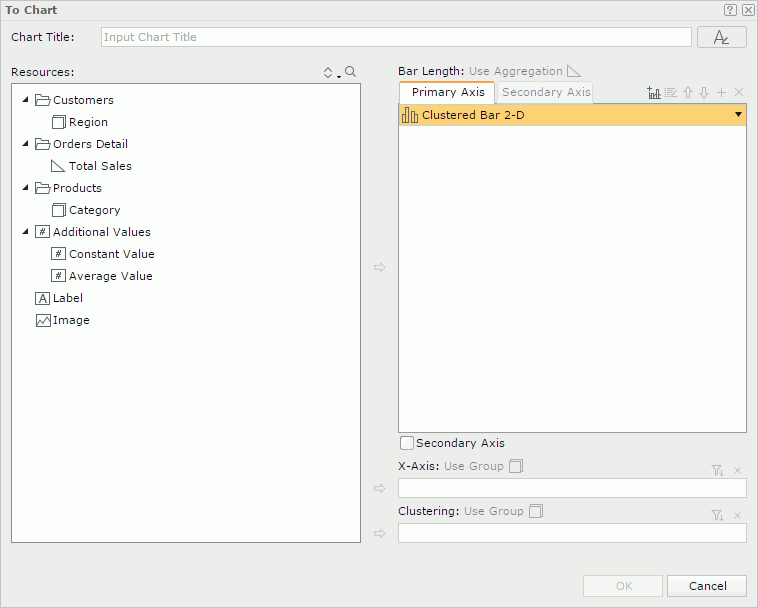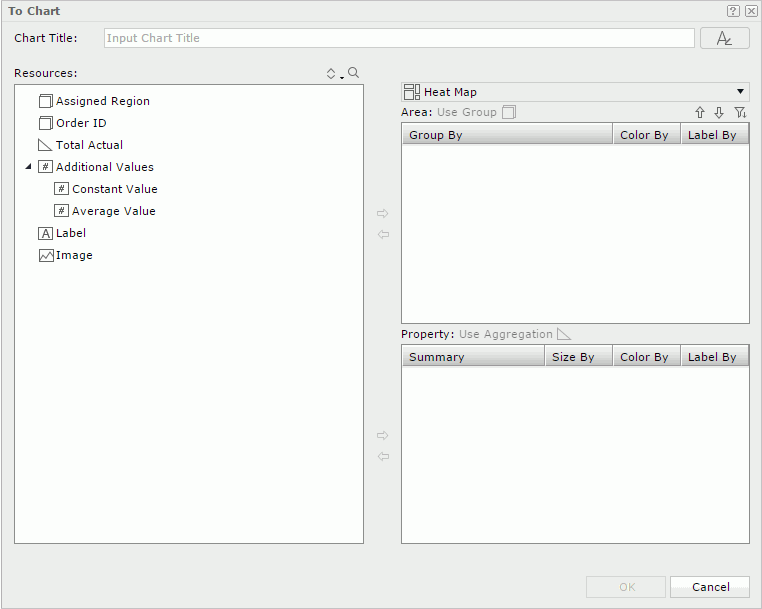To Chart
The To Chart dialog allows you to specify settings for converting a crosstab into a chart excluding the organization chart and varies with different chart types: common chart types, organization chart, heat map. This dialog appears when you right-click a crosstab and then select To Chart on the shortcut menu or select Menu > Edit > To Chart.
OK
Applies the settings and closes the dialog.
Cancel
Cancels the settings and closes the dialog.

Displays the help document about this feature.

Ignores the setting and closes this dialog.
For Common Chart Types

Title
Specifies a title for the chart.

Specifies the font properties of the chart title.
- Font
Lists all the available font faces that can be selected to apply to the title. - Font Style
Specifies the font style of the title. It can be one of the following: plain, bold, italic, and bold italic. - Size
Specifies the font size of the title. - Align
Specifies the position of the title to be left, right, center or justify. - Font Color
Specifies the font color of the title. - Background Color
Specifies the background color of the title.
Resources
Displays all the view elements used in the crosstab.

Sorts the view elements in the specified order from the drop-down list. Once a user changes the order, it will be applied to all the resource trees where business view elements are listed for this user.
- Predefined Order
Sorts the view elements in the order defined in the Business View Editor on Logi JReport Designer. - Resource Types
Sorts the view elements by resource type, namely category objects come first, then group objects, then aggregation objects, and at last detail objects. - Alphabetical Order
Sorts the view elements in alphabetical order. Elements that are not in any category will be sorted first, then the categories, and the elements in each category will also be sorted alphabetically.

Launches the search bar to search for view elements. For the usage of the search bar, see Search.

Adds the selected group or aggregation object to be displayed in the chart.
Category box
The actual name of the box varies with different chart types, for example, it is X-Axis for a clustered bar chart. The box lists the group object  that will be displayed on the category axis of the chart.
that will be displayed on the category axis of the chart.
Series box
The actual name of the box varies with different chart types, for example, it is Clustering for a clustered bar chart. The box lists the group object  that will be displayed on the series axis of the chart.
that will be displayed on the series axis of the chart.
Value box
The actual name of the box varies with different chart types, for example, it is Bar Length for a clustered bar chart. The box specifies the types for chart and sets the values for the Primary Axis or Secondary Axis separately.
- Primary Axis
Adds a chart type to the primary axis. - Secondary Axis
Adds a chart type to the secondary axis. Not available to gauge chart. - X-Axis
Lists the value you want to show on the X axis of the bubble chart. - Y-Axis
Lists the value you want to show on the Y axis of the bubble chart. - Size
Lists the value you want to show as the bubble size.
Secondary Axis
Specifies whether to show the secondary axis in the chart. Not available to gauge chart.

Opens the Category Options dialog or Series Options dialog to define the sort order of the category or series values and specify the number of the category or series values that will be displayed in the chart.

Adds a combo chart to the Primary Axis or Secondary Axis. Not available to gauge chart.

Moves the selected view element one level up.

Moves the selected view element one level down.

Adds a new pair of Y Axis and Radius for the bubble chart.

Removes the selected view element.
For Organization Chart

Chart Title
Specifies the title of the chart. The title is a special label bound with the chart. Though it can be positioned freely in a report, once you remove the chart from the report, the title will be removed too.

Specifies the font properties of the chart title.
Resources
Displays the resources that can be added to the chart.

Sorts the view elements in the specified order from the drop-down list. Once a user changes the order, it will be applied to all the resource trees where business view elements are listed for this user.

Launches the search bar to search for view elements. For the usage of the search bar, see Search.
Value box
- Primary Axis
Select Org from the chart type drop-down menu. - Node
Adds a field from the Resources box which identifies the entity by selecting both the field and Child and then selecting .
. - Parent
Adds a field from the Resources box which shows the "reporting to" relationship among the entity members, that is, which child node field member reports to or belongs to which child node field member, by selecting both the field and Parent and then selecting .
. 
Removes the selected child node or parent field.
Properties
The Properties box presents a node model of the org chart. Data fields, labels and images can be inserted into the node as the information about the entity in the org chart, using  . By default all added objects are placed at the left top of the node, you need to adjust their positions and sizes in the node. You can also resize the node if required.
. By default all added objects are placed at the left top of the node, you need to adjust their positions and sizes in the node. You can also resize the node if required.
To remove an object from the node, select it and then select  .
.
For Heat Map

Title
Specifies the title of the chart. The title is a special label bound with the chart. Though it can be positioned freely in a report, once you remove the chart from the report, the title will be removed too.

Specifies the font properties of the chart title.
Resources
Displays the resources that can be added to the chart.

Sorts the view elements in the specified order from the drop-down list. Once a user changes the order, it will be applied to all the resource trees where business view elements are listed for this user.

Launches the search bar to search for view elements. For the usage of the search bar, see Search.

Adds the selected field into the Area or Property box.

Removes the selected field from the Area or Property box.
Chart type drop-down list
Displays Heat Map as the selected chart type.
Area
Lists the fields used to group the data to different areas. There should be at least one group. When there are multiple groups, their levels are defined by their positions from top down. The group at the top is of the highest level and the bottom the lowest.
- Color by
Specifies whether to color by a group. 0-n groups can be used as the color-by fields. - Label by
Specifies whether to show the group name in the innermost rectangle. 
Moves the selected group field one level up.
Moves the selected group field one level down.
Opens the Group Options dialog to define the sort order of the group values and specify the number of the group values that will be displayed in the chart.
Removes the selected group field.
Property
Lists the summary fields used as size-by/color-by or displayed in the innermost rectangle.
- Size by
Specifies to size by one summary or none. - Color by
Specifies to color by one summary or none. - Label by
Specifies whether to show a summary in the innermost rectangle.
 Previous Topic
Previous Topic